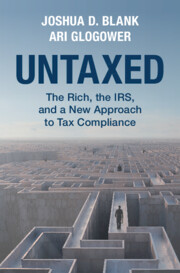Book contents
- Untaxed
- Untaxed
- Copyright page
- Dedication
- Contents
- Acknowledgments
- Introduction
- 1 Tax Noncompliance at the Top
- 2 How the Tax System Addresses Noncompliance
- 3 Means-Adjusted Tax Compliance
- 4 When Are Means Adjustments Fair and Efficient?
- 5 From Theory to Legal Design
- 6 Tax Penalties
- 7 Tax Advice
- 8 The Statute of Limitations
- 9 Tax Information Reporting
- 10 Closing the Tax Information Gap
- Conclusion
- Index
3 - Means-Adjusted Tax Compliance
A New Approach
Published online by Cambridge University Press: 22 November 2024
- Untaxed
- Untaxed
- Copyright page
- Dedication
- Contents
- Acknowledgments
- Introduction
- 1 Tax Noncompliance at the Top
- 2 How the Tax System Addresses Noncompliance
- 3 Means-Adjusted Tax Compliance
- 4 When Are Means Adjustments Fair and Efficient?
- 5 From Theory to Legal Design
- 6 Tax Penalties
- 7 Tax Advice
- 8 The Statute of Limitations
- 9 Tax Information Reporting
- 10 Closing the Tax Information Gap
- Conclusion
- Index
Summary
What are the weaknesses of the current tax compliance rules, and how can these rules more effectively address the challenge of high-end tax noncompliance? This chapter first describes the limitations of the traditional responses to tax noncompliance in the law and in prominent reform proposals. It then introduces a new approach: a system of means-adjusted tax compliance rules. As we argue, this approach can both complement the traditional responses to noncompliance and counter their limitations to build a more robust and effective tax compliance system. The final section of this chapter describes how introducing means adjustments to the tax compliance rules would not be a radically new direction for tax reform, but rather an extension and rationalization of principles that are already embedded in the current tax law.
Keywords
- Type
- Chapter
- Information
- UntaxedThe Rich, the IRS, and a New Approach to Tax Compliance, pp. 64 - 100Publisher: Cambridge University PressPrint publication year: 2024

